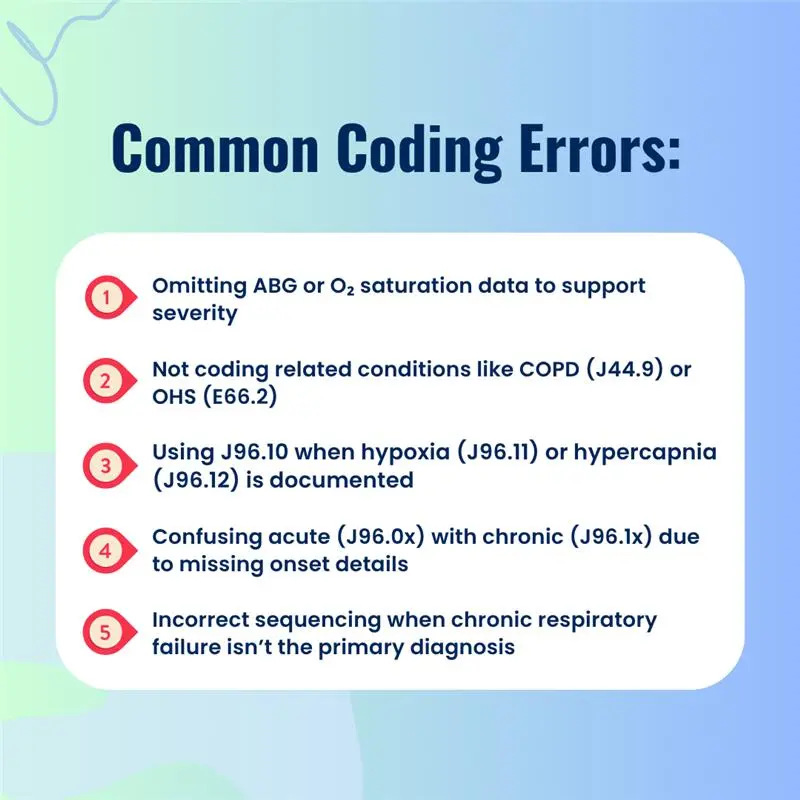One of the most pressing challenges in coding chronic respiratory failure is the high rate of claim denials. These denials frequently stem from insufficient provider documentation, inaccurate code assignment, and a failure to distinguish between acute and chronic respiratory failure or to capture key clinical indicators like hypoxia and hypercapnia. Since chronic respiratory conditions are often complex and multifactorial, any lack of specificity or incomplete correlation with the documented clinical picture can trigger payer audits, denials, or reduced reimbursement.
Insurance carriers carefully examine diagnosis-related group (DRG) assignments linked to chronic respiratory failure. Errors in sequencing, unspecified code use, and misrepresentation of the primary condition can flag claims for additional review or outright rejection. Therefore, precision in applying the ICD 10 code for chronic respiratory failure is essential not only for compliance but also for revenue integrity.
Below are some of the most common errors encountered when coding this condition:

Coders and healthcare providers must work together to ensure that documentation is both thorough and clinically justified. This blog provides a technical roadmap to help mitigate denials through precise code usage, detailed clinical correlation, and proper claim sequencing. to help mitigate denials through precise code usage, detailed clinical documentation, and proper claim sequencing.
What is Chronic Respiratory Failure?
Chronic respiratory failure occurs when the respiratory system cannot maintain adequate gas exchange over a long period. This can result from obstructive lung diseases, neuromuscular disorders, or thoracic cage abnormalities. Patients may experience fatigue, dyspnea, cyanosis, or morning headaches due to sustained hypoxemia or hypercapnia. Unlike acute respiratory failure, which is a medical emergency, chronic forms require long-term management strategies like non-invasive ventilation and oxygen therapy. Proper diagnosis and coding are essential to ensure comprehensive care planning.
ICD-10 Codes for Chronic Respiratory Failure
The ICD-10 code for chronic respiratory failure is J96.1. This code falls under the broader category J96 – Respiratory failure, not elsewhere classified. Chronic respiratory failure refers to a long-term inability of the respiratory system to maintain adequate gas exchange, either due to low oxygen levels (hypoxemia), high carbon dioxide levels (hypercapnia), or both.
| ICD-10 Code | Description | Use Case Example |
|---|---|---|
| J96.10 | Chronic respiratory failure, unspecified | Documentation lacks specifics on hypoxia/hypercapnia |
| J96.11 | Chronic respiratory failure with hypoxia | Chronic low oxygen saturation, long-term O2 use |
| J96.12 | Chronic respiratory failure with hypercapnia | Elevated CO₂ on ABG, especially in COPD patients |
| J96.00 | Acute respiratory failure, unspecified | Not to be used for chronic cases |
| J96.20 | Acute and chronic respiratory failure, unspecified | Used when both acute and chronic failure coexist |
| Z99.81 | Dependence on supplemental oxygen | Must be used when long-term O2 use is documented |
| Z99.11 | Dependence on respirator (ventilator) status | Applies to chronic ventilator-dependent patients |
Code Selection and Clinical Correlation
Accurate ICD-10 coding depends heavily on the quality of clinical documentation. Coders must interpret physician notes carefully and correlate them with diagnostic data, such as arterial blood gases and imaging studies.
When documentation lacks specificity, the default code J96.10 is used, though it’s preferable to query the provider for clarification. J96.11 should be used when hypoxemia is documented, with oxygen saturation consistently falling below accepted thresholds. J96.12 is appropriate when hypercapnia is present, typically diagnosed through ABGs revealing elevated PaCO₂.
Clinical correlation is essential. For instance, in a patient with chronic respiratory acidosis and dyspnea due to long-standing COPD, coding J96.12 in conjunction with the COPD code ensures both the symptom and etiology are captured.
Avoiding Common Coding Errors
Incorrectly assigning the ICD 10 code for chronic respiratory failure can lead to significant administrative setbacks. One common error is misidentifying acute failure as chronic or vice versa. Chronic respiratory failure develops over time, whereas acute conditions have a sudden onset. It is imperative to assess time duration and clinical documentation.
Another frequent mistake is omitting modifiers like hypoxia or hypercapnia. These subcategories are crucial, not only for data accuracy but also for reimbursement purposes. Overlooking coexisting conditions such as COPD or heart failure also limits the completeness of coding and may reduce the DRG weight, directly impacting reimbursement.
Comorbidities and Code Combinations
Chronic respiratory failure often coexists with other significant conditions, and coding should reflect this complexity. Chronic obstructive pulmonary disease (COPD), obesity hypoventilation syndrome, and heart failure are among the most common comorbidities. Each of these must be coded separately but in sequence that reflects clinical significance.
For example, a patient with chronic respiratory failure primarily due to COPD should have COPD (J44.9) coded alongside J96.1x, with the principal diagnosis determined by the condition chiefly responsible for admission. When coding multiple conditions, ICD-10 guidelines on combination coding and sequencing should always be consulted.
Best Practices in Medical Coding
Coders must cultivate habits that promote both accuracy and efficiency. When documentation is incomplete or ambiguous, querying the provider is not just recommended, it’s essential. Proper use of encoder tools and reference to the ICD-10-CM Official Guidelines for Coding and Reporting ensures compliance and minimizes errors.
Regular updates from CMS and Coding Clinics should be reviewed, especially for high-impact conditions like chronic respiratory failure, which affect DRG assignment and risk adjustment. Applying codes with an understanding of clinical context helps bridge the gap between documentation and reimbursement.
Reimbursement and Clinical Impact
How Pro-MBS Ensures Coding Precision for Chronic Respiratory Failure
We understand that coding chronic respiratory failure is not just about assigning J96.1x, it’s about ensuring complete clinical alignment, compliance, and revenue protection. Our certified medical coders work closely with providers to capture critical clinical indicators such as hypoxia (J96.11) and hypercapnia (J96.12), verify arterial blood gas values, and identify coexisting conditions like COPD, obesity hypoventilation syndrome, or heart failure for accurate sequencing.
We integrate payer-specific guidelines, DRG optimization strategies, and clinical documentation improvement (CDI) protocols into every claim review. This ensures that each diagnosis is fully substantiated, avoids unspecified coding, meets ICD-10-CM official guidelines, and withstands payer audits, safeguarding both compliance and reimbursement integrity.



